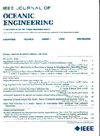声纳系统的交替重建与感知参数估计
IF 5.3
2区 工程技术
Q1 ENGINEERING, CIVIL
引用次数: 0
摘要
反卷积算法通常依赖于传统的波束形成方法来获得波束形成向量,这限制了它们的分辨率。为了提高参数估计的分辨率,本文引入了交替重建与感知(Alternating Reconstruction and Sensation,简称PEARS)算法。在该算法中,方向估计利用线性约束二次规划方法和加权l1范数求解目标函数,在固定加权向量条件下实现了更高的方向谱分辨率。该算法利用梯度下降法更新加权向量,利用链式法则计算字典矩阵、方向谱和加权向量之间的关系。这个过程改善了方向估计结果,特别是在低信噪比的情况下。该算法通过目标参数估计和权向量计算交替进行,实现了高精度的目标方位估计。仿真结果验证了该算法准确估计目标方位角的能力。此外,湖泊和海洋实验结果也证明了该算法在复杂环境下正确估计方向的有效性。本文章由计算机程序翻译,如有差异,请以英文原文为准。
Parameter Estimation by Alternating Reconstruction and Sensation for Sonar System
Deconvolution algorithms often rely on conventional beamforming methods to obtain beamforming vectors, which limit their resolution. To enhance parameter estimation resolution, this article introduces the Parameter Estimation by Alternating Reconstruction and Sensation (PEARS) algorithm. In the proposed algorithm, direction estimation leverages a linearly constrained quadratic programming method and weighted L1-norm to solve the objective function, achieving higher resolution in the direction spectrum under fixed weighted vector conditions. The algorithm utilizes the gradient descent method to update the weighted vector, and the relationship among the dictionary matrix, direction spectrum, and weighted vector is computed using the chain rule. This process improves direction estimation results, particularly in scenarios with low signal-to-noise ratios. By alternating between target parameter estimation and weight vector calculation, the PEARS algorithm achieves highly accurate target azimuth estimation. Simulation results validate the algorithm's ability to accurately estimate target azimuth angles. In addition, lake and sea experimental results demonstrate the algorithm's effectiveness in correctly estimating direction in complex environments.
求助全文
通过发布文献求助,成功后即可免费获取论文全文。
去求助
来源期刊

IEEE Journal of Oceanic Engineering
工程技术-工程:大洋
CiteScore
9.60
自引率
12.20%
发文量
86
审稿时长
12 months
期刊介绍:
The IEEE Journal of Oceanic Engineering (ISSN 0364-9059) is the online-only quarterly publication of the IEEE Oceanic Engineering Society (IEEE OES). The scope of the Journal is the field of interest of the IEEE OES, which encompasses all aspects of science, engineering, and technology that address research, development, and operations pertaining to all bodies of water. This includes the creation of new capabilities and technologies from concept design through prototypes, testing, and operational systems to sense, explore, understand, develop, use, and responsibly manage natural resources.
 求助内容:
求助内容: 应助结果提醒方式:
应助结果提醒方式:


